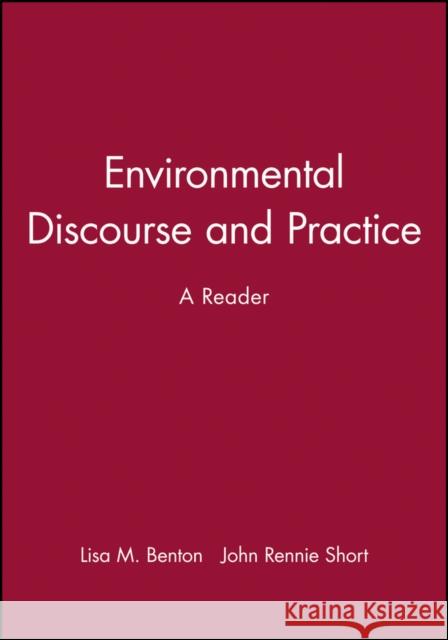Environmental Discourse and Practice: A Reader » książka



Environmental Discourse and Practice: A Reader
ISBN-13: 9780631216377 / Angielski / Miękka / 2000 / 288 str.
Environmental Discourse and Practice: A Reader
ISBN-13: 9780631216377 / Angielski / Miękka / 2000 / 288 str.
(netto: 263,92 VAT: 5%)
Najniższa cena z 30 dni: 270,17 zł
ok. 22 dni roboczych.
Darmowa dostawa!
This book brings together a set of readings that throw light on the relationship between people and the environment.
- Provides both historical background and an analysis of key debates and theories
- Based on tried and tested classroom teaching material
- Uses the idea of "environmental discourses" to explain human-environmental relationships
"The companion Reader provides a convenient collection of some important readings in environmental history and many readings from classic expressions of environmental discourses." Local Environment
Preface.
Acknowledgements.
1. Native Americans and the Environment Introduction.
A Spider′s Web (1961). Black Elk.
Ties That Bind (1990). Annie L. Booth and Harvey M. Jacobs.
How Can One Sell the Air?: A Manifesto for the Earth (ca. 1855). Chief Seattle.
The Cycle of Life. (1990) Audrey Shenandoah.
An Iroquois Perspective (1980). Oren Lyons.
2. Colonial Encounters.
Introduction.
A Certaine Indian (1621). William Bradford.
The Indians Grew Very Inquisitive (1647). John Winthrop.
Before They Got Thick (ca. early nineteenth century). Percy Bigmouth.
Give Us Good Goods (1743). Anonymous.
The Pristine Myth: The Landscape of the Americas in 1492 (1992). William M. Denevan.
The Invasion of America: Indians, Colonialism, and the Cant of Conquest (1975). Francis Jennings.
Changes in the Land: Indians, Colonists, and the Ecology of New England (1983). William Cronon.
The Columbian Exchange: Biological and Cultural Consequences of 1492 (1972). Alfred W. Crosby, Jr.
3. Territorial Expansion.
Introduction.
Moving West (1797). Daniel Boone.
The 1785 Ordnance.
The Oregon Trail (1849). Francis Parkman, Jr.
Letters Home (1863–5). Gro Svendsen.
The Garden of the World and American Agrarianism (1950). Henry Nash Smith.
American Railways (1903). Edwin Pratt.
From Report of the Lands of the Arid Region of the United States (1878). John Wesley Powell.
The Significance of the Frontier in American History (1894). Frederick Jackson Turner.
4. An American Environment.
Introduction.
The American Wilderness (1982). Roderick Nash.
From The Pioneers (1823). James Fenimore Cooper.
William Cooper′s Town (1995). Alan Taylor.
Essays on American Scenery (1835) Thomas Cole.
5. The Early Environmental Movement.
Introduction.
Walking (1862). Henry David Thorea.
Man and Nature (1864). George Perkins Marsh.
National Park Legislation, 1864.
National Park Legislation, 1872.
National Parks: The American Experience (1987) Alfred Runte.
A Voice for Wilderness (1901) John Muir.
National Park Service Legislation, 1916.
6. The Progressive Movement and the Environment.
Introduction.
The Conservation Movement and the Progressive Tradition (1959) Samuel Hays.
Conservation, Protection, Reclamation, and Irrigation (1901) Theodore Roosevelt.
Theodore Roosevelt and Conservation (1997). H. W. Brands.
The Birth of Conservation (1997). Gifford Pinchot.
Efficiency, Equity, and Esthetics: Shifting Themes in American Conservation (1978). Clayton Koppes.
7. Environmental Thinkers.
Introduction.
Thinking Like a Mountain (1949). Aldo Leopold.
The Obligation to Endure (1962). Rachel Carson.
The Economics of the Coming Spaceship Earth (1966). Kenneth E. Boulding.
.
8. The Regulatory Revolution.
Introduction.
Message to Congress (1970). Richard Nixon.
A Fierce Green Fire (1993). Philip Shabecoff.
Environmental Policy Since the 1970s (1994). Michael Kraft and Norman Vig.
Environmental Policy in the Courts (1994). Lettie Wenne.
The Environmental Impact Statement and the Rhetoric of Democracy (1992). Jimmie Killingsworth and Jacqueline Palmer.
9. The Greening of the United States.
Introduction.
Twenty Years of Environmental Mobilization (1992). Cameron Mitchell, Angel Mertig, and Riley Dunlap.
New York Days (1991) David R. Brower.
Environmental Values in American Culture (1995). Willett Kempton, James Boster, and Jennifer Hartley .
10. Debates on the Environment.
Introduction.
Environmental Overkill (1993). Dixy Ree Ray.
Ecorealism (1995). Gregg Easterbroo.
Green and Competitive (1995). Michael Porter and Class van der Linde.
11. Radical Environmental Discourses.
Introduction.
Deep Ecology (1985). Bill Devall and George Sessions.
Confessions of an Eco–Warrior (1991). Dave Foreman.
Social Ecology (1990). Murray Bookchin.
Rhetoric and Action in Ecotopian Discourse (1992). Jimmie Killingsworth and Jacqueline Palmer .
12. Gendered Environmental Discourses.
Introduction.
Ecofeminism (1992). Carolyn Merchant.
Ecofeminism and Bioregionalism (1987–8). Judith Plan.
Masculinity and Ecology (1991). Sam Keen.
13. Environmental Justice.
Introduction.
Toxic Struggles (1993). Lois Gibbs.
Anatomy of Environmental Racism (1993). Robert D. Bullard.
Principles of Environmental Justice (1991).
14. A New Ecological Order?.
Introduction.
Evironmentalism and the Future of Progressive Politics (1989). Robert C. Paehlke.
The Third Eden (1991). Stanwyn Shetler.
Toward a Healing of Self and World (1992). Joanna Macy.
The Dream of the Earth (1988). Thomas Berry .
Confessions of a Developer (1992) Wallace Kaufman.
The Hoop of the World (1961). Black Elk.
Readings: A Full Citation.
Index.
Lisa M. Benton teaches Geography and Environmental Studies at Colgate University. She is the author of The Presidio: From Army Post to National Park (1998) and numerous articles in such journals as Environmental Ethics, Environment and Planning and Urban Geography.
John Rennie Short is Professor of Geography at Syracuse University. Amongst his publications are The Humane City (1989), Imagined Country (1991), Human Settlement (1993), The Urban Order (1996), New Worlds, New Geographies (1998) and Representing the Republic (1999).
This book brings together a set of readings that throw light on the relationship between people and the environment. The editors introduce the concept of "environmental discourses" – explanations of the world around us – to help readers understand why human–environmental relationships take on the forms that they do. By using this concept as a unifying theme for the Reader, the editors show that the environment is as much a social construct as a physical presence.
This collection of key primary documents and secondary texts comprises observations, analyses and descriptions of environmental histories and contemporary environmental debates. The Reader can be used in conjunction with the editors′ textbook Environmental Discourses and Practice: An Introduction or independently as an indispensable resource for all students of the environment.
1997-2025 DolnySlask.com Agencja Internetowa
KrainaKsiazek.PL - Księgarnia Internetowa









